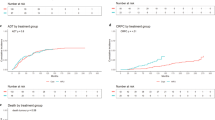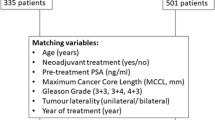Abstract
Purpose
To describe the national-level patterns of care for local ablative therapy among men with PCa and identify patient- and hospital-level factors associated with the receipt of these techniques.
Methods
We retrospectively interrogated the National Cancer Database (NCDB) for men with clinically localized PCa between 2010 and 2017. The main outcome was receipt of local tumor ablation with either cryo- or laser-ablation, and “other method of local tumor destruction including high-intensity focused ultrasound (HIFU)”. Patient level, hospital level, and demographic variables were collected. Mixed effect logistic regression models were fitted to identify separately patient- and hospital-level predictors of receipt of local ablative therapy.
Results
Overall, 11,278 patients received ablative therapy, of whom 78.8% had cryotherapy, 15.6% had laser, and 5.7% had another method including HIFU. At the patient level, men with intermediate-risk PCa were more likely to be treated with local ablative therapy (OR 1.05; 95% CI 1.00–1.11; p = 0.05), as were men with Charlson Comorbidity Index > 1 (OR 1.36; 95% CI 1.29–1.43; p < 0.01), men between 71 and 80 years (OR 3.70; 95% CI 3.43–3.99; p < 0.01), men with Medicare insurance (OR 1.38; 95% 1.31–1.46; p < 0.01), and an income < $47,999 (OR 1.16; 95% CI 1.06–1.21; p < 0.01). At the hospital-level, local ablative therapy was less likely to be performed in academic/research facilities (OR 0.45; 95% CI 0.32–0.64; p < 0.01).
Conclusions
Local ablative therapy for PCa treatment is more commonly offered among older and comorbid patients. Future studies should investigate the uptake of these technologies in non-hospital-based settings and in light of recent changes in insurance coverage.
Similar content being viewed by others
Data availability
Application and access to the registry can be obtained only if the provider or researcher is affiliated to a Commission on Cancer accredited program.
References
Kasivisvanathan V, Rannikko AS, Borghi M et al (2018) MRI-targeted or standard biopsy for prostate-cancer diagnosis. N Engl J Med 378(19):1767–1777
Giganti F, Cole AP, Fennessy FM et al (2023) Promoting the use of the PI-QUAL score for prostate MRI quality: results from the ESOR Nicholas Gourtsoyiannis teaching fellowship. Eur Radiol 33(1):461–471
Salagierski M, Wojciechowska A, Zając K et al (2018) The role of ablation and minimally invasive techniques in the management of small renal masses. Eur Urol Oncol 1(5):395–402
Weinreb JC, Barentsz JO, Choyke PL et al (2016) PI-RADS prostate imaging—reporting and data system: 2015, version 2. Eur Urol 69(1):16–40
Eggener S, Salomon G, Scardino PT, De la Rosette J, Polascik TJ, Brewster S (2010) Focal therapy for prostate cancer: possibilities and limitations. Eur Urol 58(1):57–64
Tyson MD, Koyama T, Lee D et al (2018) Effect of prostate cancer severity on functional outcomes after localized treatment: comparative effectiveness analysis of surgery and radiation study results. Eur Urol 74(1):26–33
Ljungberg B, Albiges L, Abu-Ghanem Y et al (2019) European Association of Urology guidelines on renal cell carcinoma: the 2019 update. Eur Urol 75(5):799–810
Campbell Steven C, Novick Andrew C, Belldegrun A et al (2009) Guideline for management of the clinical T1 renal mass. J Urol 182(4):1271–1279
Guillaumier S, Peters M, Arya M et al (2018) A multicentre study of 5-year outcomes following focal therapy in treating clinically significant nonmetastatic prostate cancer. Eur Urol 74(4):422–429
Westhoff N, Ernst R, Kowalewski KF et al (2021) Treatment decision satisfaction and regret after focal HIFU for localized prostate cancer. World J Urol 39(4):1121–1129
Reddy D, Peters M, Shah TT et al (2022) Cancer control outcomes following focal therapy using high-intensity focused ultrasound in 1379 men with nonmetastatic prostate cancer: a multi-institute 15-year experience. Eur Urol 81(4):407–413
Hopstaken JS, Bomers JGR, Sedelaar MJP, Valerio M, Fütterer JJ, Rovers MM (2022) An updated systematic review on focal therapy in localized prostate cancer: what has changed over the past 5 years? Eur Urol 81(1):5–33
Bilimoria KY, Stewart AK, Winchester DP, Ko CY (2008) The National Cancer Data Base: a powerful initiative to improve cancer care in the United States. Ann Surg Oncol 15(3):683–690
Cole AP, Friedlander DF, Trinh Q-D (2018) Secondary data sources for health services research in urologic oncology. Urol Oncol: Semin Orig Investig 36(4):165–173
D’Amico AV, Whittington R, Malkowicz SB et al (1998) Biochemical outcome after radical prostatectomy, external beam radiation therapy, or interstitial radiation therapy for clinically localized prostate cancer. JAMA 280(11):969–974
Sundararajan V, Henderson T, Perry C, Muggivan A, Quan H, Ghali WA (2004) New ICD-10 version of the Charlson comorbidity index predicted in-hospital mortality. J Clin Epidemiol 57(12):1288–1294
Mortezavi A, Krauter J, Gu A et al (2019) Extensive histological sampling following focal therapy of clinically significant prostate cancer with high intensity focused ultrasound. J Urol 202(4):717–724
Lambert EH, Bolte K, Masson P, Katz AE (2007) Focal cryosurgery: encouraging health outcomes for unifocal prostate cancer. Urology 69(6):1117–1120
Mandel P, Chandrasekar T, Chun FK, Huland H, Tilki D (2017) Radical prostatectomy in patients aged 75 years or older: review of the literature. Asian J Androl 21(1):32–36
Shahait M, Labban M, Dobbs RW et al (2020) A 5-item frailty index for predicting morbidity and mortality after radical prostatectomy: an analysis of the American College of Surgeons National Surgical Quality Improvement Program Database. J Endourol 35(4):483–489
American Urological Association. Clinically localized prostate cancer: AUA/ASTRO/SUO guideline (2017). https://www.auanet.org/guidelines/guidelines/prostate-cancer-clinically-localized-guideline. Published 2017. Accessed 17 Feb 2022
Wysock JS, Lepor H (2018) Optimizing patient selection for focal therapy-mapping and ablating the index lesion. Transl Androl Urol 7(Suppl 4):S519-s525
Mahal BA, Berman RA, Taplin M-E, Huang FW (2018) Prostate cancer-specific mortality across Gleason scores in black vs nonblack men. JAMA 320(23):2479–2481
Trinh QD, Hong F, Halpenny B, Epstein M, Berry DL (2020) Racial/ethnicity differences in endorsing influential factors for prostate cancer treatment choice: an analysis of data from the personal patient profile-prostate (P3P) I and II trials. Urol Oncol 38(3):78.e77-78.e13
van der Poel H, Klotz L, Andriole G et al (2015) Role of active surveillance and focal therapy in low- and intermediate-risk prostate cancers. World J Urol 33(7):907–916
Babaian RJ, Donnelly B, Bahn D et al (2008) Best practice statement on cryosurgery for the treatment of localized prostate cancer. J Urol 180(5):1993–2004
Petrelli NJ (2010) A community cancer center program: getting to the next level. J Am Coll Surg 210(3):261–270
Cole AP, Chen X, Langbein BJ et al (2022) Geographic variability, time trends and association of preoperative magnetic resonance imaging with surgical outcomes for elderly United States men with prostate cancer: a Surveillance, Epidemiology, and End Results-Medicare analysis. J Urol 208(3):609–617
Wang AZ, Lebastchi AH, O’Connor LP et al (2021) Making a case “for” focal therapy of the prostate in intermediate risk prostate cancer: current perspective and ongoing trials. World J Urol 39(3):729–739
Labban M, Briggs L, Cole AP, Trinh QD (2021) Measuring what matters: patient-reported outcome and experience measures for men undergoing radical prostatectomy. Eur Urol Focus 7(5):913–915
Funding
No funding was received for conducting this study.
Author information
Authors and Affiliations
Contributions
MK: project development, data management, data analysis, manuscript writing. ML: data analysis and manuscript writing. NF: data management and manuscript editing. CPM: project development and manuscript editing. GS: project development and manuscript editing. SRL: project development, data analysis and manuscript editing. JW: project development and manuscript editing. CMM: project development, data management, and manuscript writing. CMT: project development and manuscript editing. KT: project development and manuscript editing. AG: project development and manuscript editing. ASK: project development and manuscript writing. Q-DT: project development, data analysis, and manuscript writing. APC: project development, data management, data analysis, manuscript writing.
Corresponding author
Ethics declarations
Conflict of interest
MK is supported by a postdoc fellowship from the German Academic Exchange Service (DAAD). CMT reports funding from NIH, Clinical trial support from InSightec Inc and serves as an advisor to Profound Medical ASK reports advisory board positions on hormone treatment for prostate cancer with Janssen and Myovant, and advisory board positions in the realm of prostate cancer with Bayer, Profound, Insightec, and Exelixis. ASK is also part of the Data Safety and Monitoring Committee with Bristol Myers Squibb and Advantage. QDT reports research funding from the American Cancer Society and Pfizer Global Medical Grants. APC reports research funding from the American Cancer Society and Pfizer Global Medical Grants. The remaining authors report no disclosures.
Ethical approval
An institutional review board waiver was obtained at Mass General Brigham (2016P000517).
Consent
Not applicable.
Research involving human participants and/or animals
This retrospective chart review study involving human participants was in accordance with the ethical standards of the institutional and national research committee and with the 1964 Helsinki Declaration and its later amendments or comparable ethical standards. Approval was granted by the Mass General Brigham Institutional Review Board (2016P000517).
Informed consent
This is a de-identified data registry available to participating Commission of Cancer Institutions, and informed consent is not required.
Additional information
Publisher's Note
Springer Nature remains neutral with regard to jurisdictional claims in published maps and institutional affiliations.
Supplementary Information
Below is the link to the electronic supplementary material.
Rights and permissions
Springer Nature or its licensor (e.g. a society or other partner) holds exclusive rights to this article under a publishing agreement with the author(s) or other rightsholder(s); author self-archiving of the accepted manuscript version of this article is solely governed by the terms of such publishing agreement and applicable law.
About this article
Cite this article
Koelker, M., Labban, M., Frego, N. et al. Contemporary patterns of local ablative therapies for prostate cancer at United States cancer centers: results from a national registry. World J Urol 41, 1309–1315 (2023). https://doi.org/10.1007/s00345-023-04354-7
Received:
Accepted:
Published:
Issue Date:
DOI: https://doi.org/10.1007/s00345-023-04354-7




